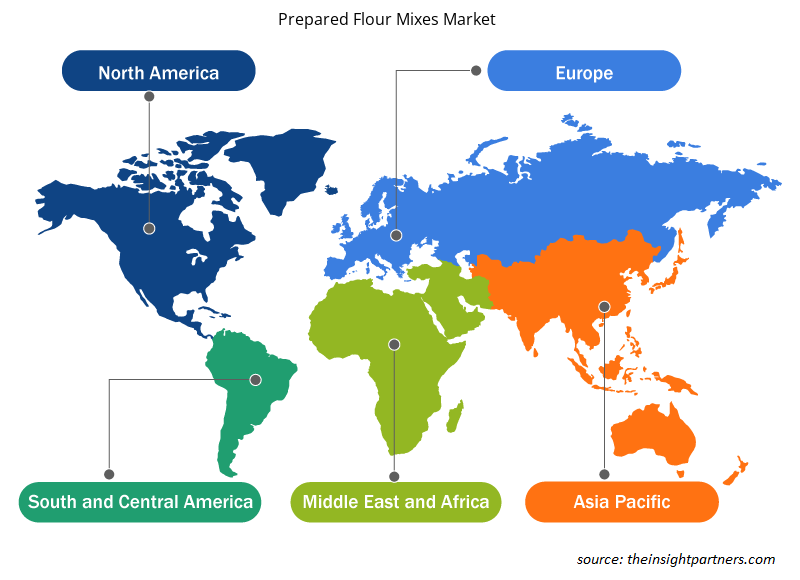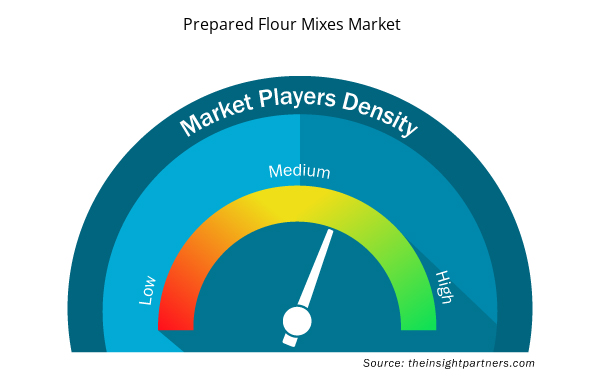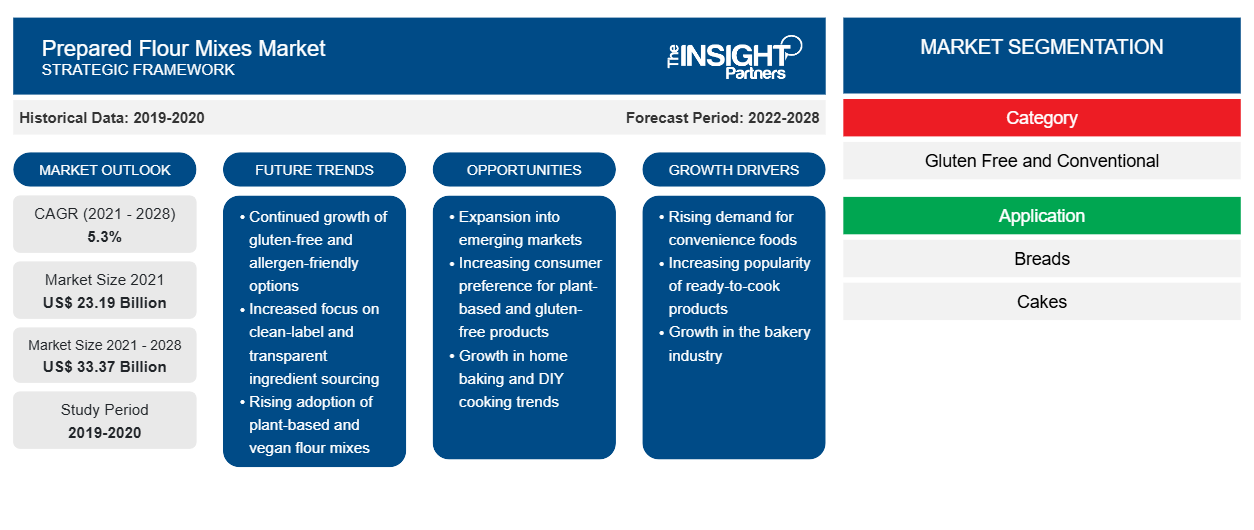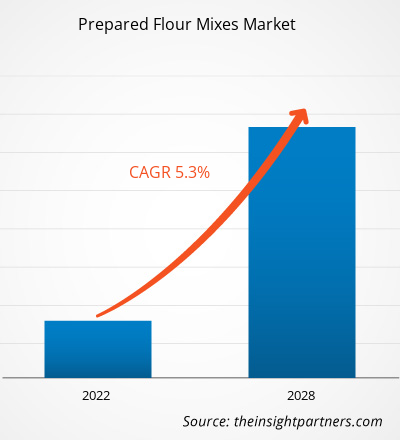预计预制面粉混合物市场将从 2021 年的 231.9215 亿美元增长到 2028 年的 333.7085 亿美元;预计从 2021 年到 2028 年的复合年增长率为 5.3%。
预制面粉混合物是各种成分的现成干混合物,例如面粉、功能性成分、淀粉、调味料等。此外,它们还含有特定品质的成分,有助于减少卡路里并提供额外的营养,例如必需脂肪、维生素和碳水化合物。预制面粉混合物广泛应用于各种行业,例如食品服务行业、烘焙和糖果行业。由于预制面粉混合物具有诸多优点,例如准备时间短、风味和质地均衡,这些行业对预制面粉混合物的采用正在增加,这反过来又推动了预制面粉混合物市场的增长。
2020 年,亚太地区占据全球预拌面粉市场的最大份额,预计北美将成为预测期内增长最快的市场。近年来,由于中国中产阶级人口不断增加、生活方式和饮食不断西化以及对包括预拌面粉在内的方便食品的需求不断增加,中国的烘焙行业发展迅速,推动了市场增长。
定制此报告以满足您的需求
您可以免费定制任何报告,包括本报告的部分内容、国家级分析、Excel 数据包,以及为初创企业和大学提供优惠和折扣
- 获取此报告的关键市场趋势。这个免费样品将包括数据分析,从市场趋势到估计和预测。
COVID-19 疫情对预制面粉混合料市场的影响
在初期,COVID-19 疫情给包括食品饮料行业在内的各个行业的供应链带来了挑战。然而,随着疫苗在全球的推广,随着之前实施的限制措施在各个地区逐渐放松,企业正在取得进展。各国政府推出的 COVID-19 疫苗缓解了局势,导致全球商业活动增加。由于全球疫苗接种率上升,全球市场已开始从损失中恢复,预计这将在未来几年推动预制面粉混合市场的增长。此外,电子商务平台凭借其广泛的物流和分销能力,在恢复产品销售方面发挥了重要作用。在线零售平台将产品送到消费者家门口。这些因素预计将在未来为市场创造有利可图的机会。
市场洞察
亚太地区对预拌面粉的需求不断增加
亚太地区的预制面粉混合料市场分为澳大利亚、中国、印度、日本、韩国和亚太其他地区。预计该地区旅游业的增加将在预测期内推动亚太市场的发展。预计印度、越南、中国、新加坡和泰国等国游客数量的增加将推动面包和蛋糕等烘焙产品的消费。此外,由于预制面粉混合料很容易添加天然成分以增加营养成分,因此预计未来几年对预制面粉混合料的需求将增加。
类别洞察
根据类别,预制面粉混合物市场分为无麸质和传统两类。2020 年,传统部分占据了更大的市场份额。传统的预制面粉混合物由各种传统成分制成,例如盐、糖、乳化剂、脂肪、小麦粉和含有麸质的乳制品。传统混合物的价格低于无麸质混合物的价格。传统混合物可能会带来不利的健康问题,并可能导致乳糜泻,这是一种因食用麸质而引起的自身免疫性疾病,因此可能会阻碍食品和饮料行业采用传统的预制面粉混合物。
应用程序洞察
根据用途,全球预制面粉混合物市场分为面包、蛋糕和其他。预制面粉混合物是专业面包师在制作面包时使用的重要产品。它易于使用、确保质量并且具有成本效益。
AB Mauri、PURATOS、Lesaffre、Archer Daniels Midland Company、General Mills, Inc.、Kerry Group、Swiss Bake Ingredients Pvt. Ltd、GR Wright & Sons、Nitto-Fuji International Vietnam Co., Ltd 和 Allied Pinnacle 是预拌面粉市场的参与者。这些公司不断努力扩大和多样化其市场占有率,并在不同地区吸引新客户。
预制面粉混合料市场区域洞察
Insight Partners 的分析师已详细解释了预测期内影响预制面粉混合料市场的区域趋势和因素。本节还讨论了北美、欧洲、亚太地区、中东和非洲以及南美和中美洲的预制面粉混合料市场细分和地理位置。

- 获取预制面粉混合料市场的区域特定数据
预制面粉混合料市场报告范围
| 报告属性 | 细节 |
|---|---|
| 2021 年市场规模 | 231.9亿美元 |
| 2028 年市场规模 | 333.7亿美元 |
| 全球复合年增长率(2021 - 2028) | 5.3% |
| 史料 | 2019-2020 |
| 预测期 | 2022-2028 |
| 涵盖的领域 | 按类别
|
| 覆盖地区和国家 | 北美
|
| 市场领导者和主要公司简介 |
|
市场参与者密度:了解其对商业动态的影响
预制面粉混合料市场正在快速增长,这得益于终端用户需求的不断增长,这些需求源于消费者偏好的不断变化、技术进步以及对产品优势的认识不断提高等因素。随着需求的增加,企业正在扩大其产品范围,进行创新以满足消费者的需求,并利用新兴趋势,从而进一步推动市场增长。
市场参与者密度是指在特定市场或行业内运营的企业或公司的分布情况。它表明在给定市场空间中,相对于其规模或总市场价值,有多少竞争对手(市场参与者)存在。
在预拌面粉市场运营的主要公司有:
- AB毛利
- 普拉托斯
- 乐斯福
- 阿彻丹尼尔斯米德兰公司
- 通用磨坊公司
免责声明:上面列出的公司没有按照任何特定顺序排列。

- 获取预制面粉混合市场顶级关键参与者概述
报告亮点
- 预制面粉混合料市场的渐进式行业趋势可帮助参与者制定有效的长期战略
- 发达市场和发展中市场采用的业务增长战略
- 2019 年至 2028 年预制面粉混合物市场的定量分析
- 全球预拌面粉需求量估计
- 波特的五力分析说明了行业中买家和供应商的效力
- 了解竞争市场状况的最新发展
- 市场趋势和前景以及推动和抑制预制面粉混合市场增长的因素
- 通过强调支撑商业利益的市场策略来协助决策过程,从而促进市场增长
- 不同节点的预制面粉混合市场规模
- 市场详细概述和细分,以及预制面粉混合料行业动态
- 各地区预拌面粉市场规模及增长潜力巨大
预制面粉混合料市场 – 按类别
- 不含麸质
- 传统的
预拌面粉市场——按用途划分
- 面包
- 蛋糕
- 其他的
公司简介
- AB毛利
- 普拉托斯
- 乐斯福
- 阿彻丹尼尔斯米德兰公司
- 通用磨坊公司
- 嘉里集团
- 瑞士烘焙配料私人有限公司
- GR 赖特父子
- 日东富士国际越南有限公司
- 盟军巅峰
- 历史分析(2 年)、基准年、预测(7 年)及复合年增长率
- PEST 和 SWOT 分析
- 市场规模价值/数量 - 全球、区域、国家
- 行业和竞争格局
- Excel 数据集


- Vaginal Specula Market
- Photo Editing Software Market
- Nitrogenous Fertilizer Market
- Authentication and Brand Protection Market
- Electronic Signature Software Market
- Advanced Planning and Scheduling Software Market
- Cell Line Development Market
- Fishing Equipment Market
- Real-Time Location Systems Market
- Visualization and 3D Rendering Software Market

Report Coverage
Revenue forecast, Company Analysis, Industry landscape, Growth factors, and Trends

Segment Covered
This text is related
to segments covered.

Regional Scope
North America, Europe, Asia Pacific, Middle East & Africa, South & Central America

Country Scope
This text is related
to country scope.
常见问题
Based on application, the cakes segment is projected to register the fastest CAGR from 2021 to 2028. The prepared flour mixes are convenient as there is less stock management and requires less preparation time while making cake. These mixes are used in making tailor made cakes as these cake mixes are specifically designed for a particular type of cake and is adapted perfectly to provide a great finished product.
Based on category, the gluten free segment is projected to grow at the fastest CAGR over the forecast period owing to the rising consumer awareness regarding the health benefits associated with the consumption of gluten free bakery products.
Based on application, the global prepared flour mixes market is segmented into breads, cakes and others. Prepared flour mixes is a vital product used in the preparation of breads by professional bakers as it provides ease of use, ensures quality, and is cost-effective. Bakers are opting prepared flour mixes for breads rather than making bread from scratch. This in turn is fueling the growth of the overall market.
Based on category, the prepared flour mixes market is segmented into gluten free and conventional. In 2020, the conventional segment held the largest share of the global prepared flour mixes market. The conventional prepared flour mixes are made of traditional ingredients such as salt, sugars, emulsifiers, fats, wheat flour, and dairy products that include gluten. The price of conventional prepared flour mixes is less compared to gluten free bakery products which in turn is driving the growth of the market.
Some of the prominent players operating in the global prepared flour mixes market include AB Mauri, PURATOS, Lesaffre, Archer Daniels Midland Company, General Mills, Inc., Kerry Group, Swiss Bake Ingredients Pvt. Ltd, G.R Wright & Sons, Nitto-Fuji International Vietnam Co., Ltd, and Allied Pinnacle.
In 2020, Asia-Pacific held the largest share in the prepared flour mixes market. The rapid mushrooming of western restaurants offering baked goods in Asia-Pacific is also fueling the demand for bakery products in the region. This in turn has driven the growth of the prepared flour mixes market in terms of value sales.
Trends and growth analysis reports related to Food and Beverages : READ MORE..
The List of Companies - Prepared Flour Mixes Market
- AB Mauri
- PURATOS
- Lesaffre
- Archer Daniels Midland Company
- General Mills, Inc.
- Kerry Group
- Swiss Bake Ingredients Pvt. Ltd
- G.R Wright & Sons
- Nitto-Fuji International Vietnam Co., Ltd
- Allied Pinnacle
The Insight Partners performs research in 4 major stages: Data Collection & Secondary Research, Primary Research, Data Analysis and Data Triangulation & Final Review.
- Data Collection and Secondary Research:
As a market research and consulting firm operating from a decade, we have published and advised several client across the globe. First step for any study will start with an assessment of currently available data and insights from existing reports. Further, historical and current market information is collected from Investor Presentations, Annual Reports, SEC Filings, etc., and other information related to company’s performance and market positioning are gathered from Paid Databases (Factiva, Hoovers, and Reuters) and various other publications available in public domain.
Several associations trade associates, technical forums, institutes, societies and organization are accessed to gain technical as well as market related insights through their publications such as research papers, blogs and press releases related to the studies are referred to get cues about the market. Further, white papers, journals, magazines, and other news articles published in last 3 years are scrutinized and analyzed to understand the current market trends.
- Primary Research:
The primarily interview analysis comprise of data obtained from industry participants interview and answers to survey questions gathered by in-house primary team.
For primary research, interviews are conducted with industry experts/CEOs/Marketing Managers/VPs/Subject Matter Experts from both demand and supply side to get a 360-degree view of the market. The primary team conducts several interviews based on the complexity of the markets to understand the various market trends and dynamics which makes research more credible and precise.
A typical research interview fulfils the following functions:
- Provides first-hand information on the market size, market trends, growth trends, competitive landscape, and outlook
- Validates and strengthens in-house secondary research findings
- Develops the analysis team’s expertise and market understanding
Primary research involves email interactions and telephone interviews for each market, category, segment, and sub-segment across geographies. The participants who typically take part in such a process include, but are not limited to:
- Industry participants: VPs, business development managers, market intelligence managers and national sales managers
- Outside experts: Valuation experts, research analysts and key opinion leaders specializing in the electronics and semiconductor industry.
Below is the breakup of our primary respondents by company, designation, and region:

Once we receive the confirmation from primary research sources or primary respondents, we finalize the base year market estimation and forecast the data as per the macroeconomic and microeconomic factors assessed during data collection.
- Data Analysis:
Once data is validated through both secondary as well as primary respondents, we finalize the market estimations by hypothesis formulation and factor analysis at regional and country level.
- Macro-Economic Factor Analysis:
We analyse macroeconomic indicators such the gross domestic product (GDP), increase in the demand for goods and services across industries, technological advancement, regional economic growth, governmental policies, the influence of COVID-19, PEST analysis, and other aspects. This analysis aids in setting benchmarks for various nations/regions and approximating market splits. Additionally, the general trend of the aforementioned components aid in determining the market's development possibilities.
- Country Level Data:
Various factors that are especially aligned to the country are taken into account to determine the market size for a certain area and country, including the presence of vendors, such as headquarters and offices, the country's GDP, demand patterns, and industry growth. To comprehend the market dynamics for the nation, a number of growth variables, inhibitors, application areas, and current market trends are researched. The aforementioned elements aid in determining the country's overall market's growth potential.
- Company Profile:
The “Table of Contents” is formulated by listing and analyzing more than 25 - 30 companies operating in the market ecosystem across geographies. However, we profile only 10 companies as a standard practice in our syndicate reports. These 10 companies comprise leading, emerging, and regional players. Nonetheless, our analysis is not restricted to the 10 listed companies, we also analyze other companies present in the market to develop a holistic view and understand the prevailing trends. The “Company Profiles” section in the report covers key facts, business description, products & services, financial information, SWOT analysis, and key developments. The financial information presented is extracted from the annual reports and official documents of the publicly listed companies. Upon collecting the information for the sections of respective companies, we verify them via various primary sources and then compile the data in respective company profiles. The company level information helps us in deriving the base number as well as in forecasting the market size.
- Developing Base Number:
Aggregation of sales statistics (2020-2022) and macro-economic factor, and other secondary and primary research insights are utilized to arrive at base number and related market shares for 2022. The data gaps are identified in this step and relevant market data is analyzed, collected from paid primary interviews or databases. On finalizing the base year market size, forecasts are developed on the basis of macro-economic, industry and market growth factors and company level analysis.
- Data Triangulation and Final Review:
The market findings and base year market size calculations are validated from supply as well as demand side. Demand side validations are based on macro-economic factor analysis and benchmarks for respective regions and countries. In case of supply side validations, revenues of major companies are estimated (in case not available) based on industry benchmark, approximate number of employees, product portfolio, and primary interviews revenues are gathered. Further revenue from target product/service segment is assessed to avoid overshooting of market statistics. In case of heavy deviations between supply and demand side values, all thes steps are repeated to achieve synchronization.
We follow an iterative model, wherein we share our research findings with Subject Matter Experts (SME’s) and Key Opinion Leaders (KOLs) until consensus view of the market is not formulated – this model negates any drastic deviation in the opinions of experts. Only validated and universally acceptable research findings are quoted in our reports.
We have important check points that we use to validate our research findings – which we call – data triangulation, where we validate the information, we generate from secondary sources with primary interviews and then we re-validate with our internal data bases and Subject matter experts. This comprehensive model enables us to deliver high quality, reliable data in shortest possible time.


 获取此报告的免费样本
获取此报告的免费样本